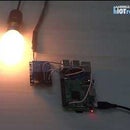Introduction: Analog Speedometer Using Arduino and IR Sensor
The project describes an analog speedometer where we have used IR Sensor to calculate speed.
Supplies
Hardware Components
Arduino Uno
Bipolar Stepper Motor
L298N Motor driver
IR Sensor Module
2.2k ohm Register
Connecting wires
Power Supply
Software Component
Arduino IDE
Step 1: About Project
Here we have used IR Sensor which can recognize the presence of an object in front of it. We have also utilized two-blade rotors and put the IR sensor near it in a way that when the blades rotate every time the IR sensor recognizes it. We employ the support of timers and Interrupts in Arduino to estimate the time taken for one entire rotation of the motor. Here it is a two-blade rotor, which means the function will be ordered 4 times in one revolution.
We can measure the RPM by utilizing the formulae, Where 1000/time taken will give us the RPS and multiplying it with 60 will give us the RPM. rpm = (60/2)*(1000/(millis() - time))*REV/bladesInFan; From this we get RPM then speed can be estimated by below formula: Speed = rpm * (2 * Pi * radius) / 1000 Before putting the values, we need to convert radius from inches to meters radius = ((radius * 2.54)/100.0) meters Speed= rpm * 60.0 * (2.0 * 3.14 * radius)/ 1000.0) in kilometers per hour Here we have worked with a 4 wire bipolar stepper motor for analog meter, which is having 200 steps per revolution. Now we need to show 280 Kmh on the speedometer. For this stepper motor requires to move 280 degree Here we have maxSpeed = 280 so the steps will be, maxSteps = 280/1.8 = 155 steps In the Arduino code, a map function is used to map speed into steps. Steps = map(speed,0,maxSpeed,0,maxSteps); After counting steps we can easily apply these steps in stepper motor function to drive a stepper motor. Here IoTCourse will give a thorough view of such IoT Applications with its practical implementation.











